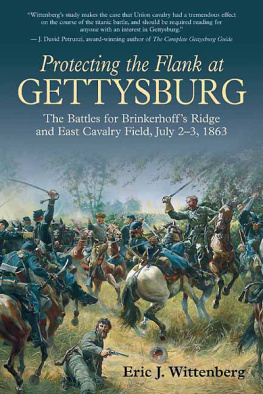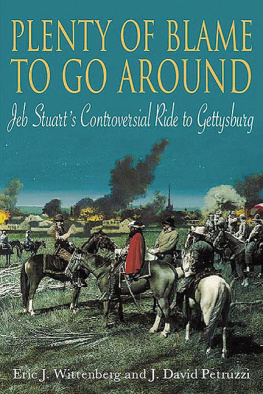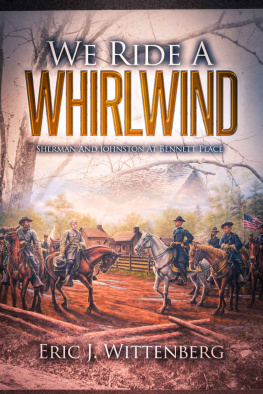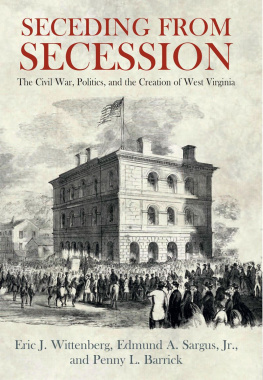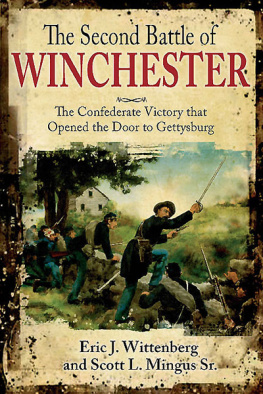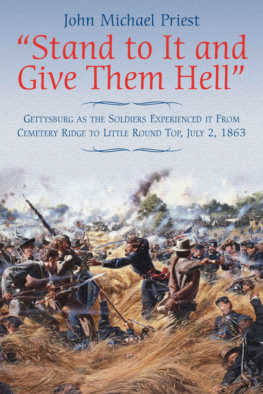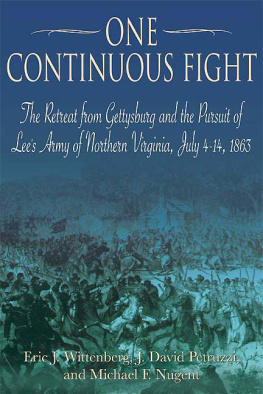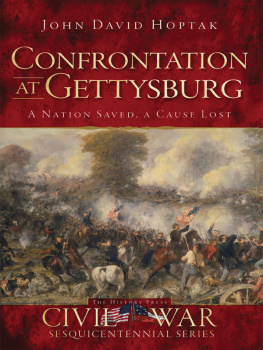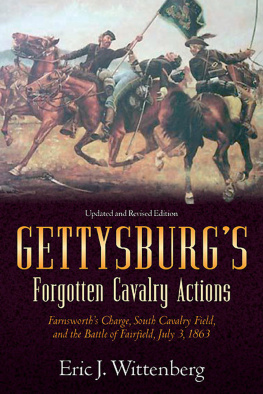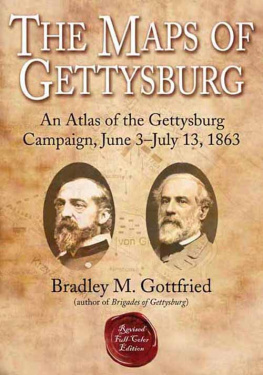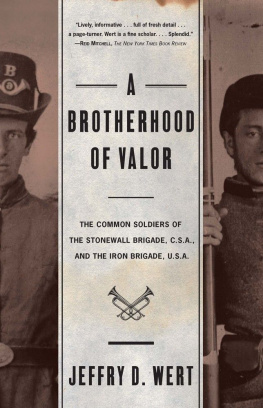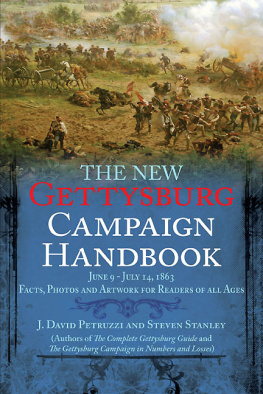
2002, 2013 by Eric J. Wittenberg
Originally published as Protecting the Flanks: The Battles for Brinkerhoffs
Ridge and East Cavalry Field, Battle of Gettysburg, July 2-3, 1863 (Ironclad
Publishing, 2002).
All rights reserved. No part of this publication may be reproduced, stored in
a retrieval system, or transmitted, in any form or by any means, electronic,
mechanical, photocopying, recording, or otherwise, without the prior written
permission of the publisher.
Library of Congress Cataloging-in-Publication Data
Wittenberg, Eric J., 1961
[Protecting the Flank]
Protecting the Flank at Gettysburg : the Battles for Brinkerhoffs Ridge and
East Cavalry Field, July 2-3, 1863 / Eric J. Wittenberg. First Savas Beatie
edition, completely revised and expanded.
pages cm
Original title: Protecting the flank.
Includes bibliographical references and index.
PRINT ISBN 978-1-61121-094-1
EPUB ISBN: 9781611210958
1. Gettysburg, Battle of, Gettysburg, Pa., 1863. 2. Pennsylvania
HistoryCivil War, 1861-1865Cavalry operations. 3. United States
HistoryCivil War, 1861-1865Cavalry operations. I. Title.
E475.53.W76 2013
973.7'349dc23
2012051775

Published by
Savas Beatie LLC
989 Governor Drive, Suite 102
El Dorado Hills, California 95762
Phone: 916-941-6896
E-mail:
Savas Beatie titles are available at special discounts for bulk purchases in
the United States by corporations, institutions, and other organizations. For more
details, please contact Special Sales, P.O. Box 4527, El Dorado Hills, CA 95762,
or you may e-mail us at , or visit our website at
www.savasbeatie.com for additional information.
Printed in the United States of America
This work is respectfully dedicated to the horse soldiers of the Union and Confederacy, who followed their respective guidons into battle on many a field, and to the memory of those men who gave the last full measure of their devotion to the causes they believed in. It is also dedicated to my parents, Joseph and Leah Wittenberg, who have always encouraged me to study and learn.
Other Books by Eric J. Wittenberg
Gettysburgs Forgotten Cavalry Actions (1998, 2011)
We Have it Damned Hard Out Here: The Civil War Letters of Sgt. Thomas W. Smith, Sixth Pennsylvania Cavalry (1999)
One of Custers Wolverines: The Civil War Letters of Brevet Brigadier General James H. Kidd, 6th Michigan Cavalry (2000)
Under Custers Command: The Civil War Journal of James Henry Avery (2000)
At Custers Side: The Civil War Writings of James Harvey Kidd (2001)
Glory Enough for All: Sheridans Second Raid and the Battle of Trevilian Station (2001)
With Sheridan in the Final Campaign Against Lee (2002)
Little Phil: A Reassessment of the Civil War Leadership of Gen. Philip H. Sheridan (2002)
The Union Cavalry Comes of Age: Hartwood Church to Brandy Station, 1863 (2003)
The Battle of Monroes Crossroads and the Civil Wars Final Campaign (2006)
Plenty of Blame to Go Around: Jeb Stuarts Controversial Ride to Gettysburg (with J. David Petruzzi, 2006)
Rushs Lancers: The Sixth Pennsylvania Cavalry in the Civil War (2007)
One Continuous Fight: The Retreat from Gettysburg and the Pursuit of Lees Army of Northern Virginia, July 4-14, 1863 (with J. David Petruzzi and Michael F. Nugent, 2008)
Like a Meteor Blazing Brightly: The Short but Controversial Life of Colonel Ulric Dahlgren (2009)
The Battle of Brandy Station: North Americas Largest Cavalry Battle (2010)
The Cavalry Charge
by Francis A. Durivage
With bray of the trumpet
And roll of the drum,
And keen ring of bugle,
The cavalry come.
Sharp clank the steel scabbards,
The bridle-chains ring,
And foam from red nostrils
The wild chargers fling.
Tramp! tramp! oer the greensward
That quivers below,
Scarce held by the curb-bit
The fierce horses go!
And the grim-visaged colonel,
With ear-rending shout,
Peals forth to the squadrons
The order Trot out!
One hand on the sabre,
And one on the rein,
The troopers move forward
In line on the plain.
As rings the word Gallop!
The steel scabbards clank,
And each rowel is pressed
To a horses hot flank:
And swift is their rush
As the wild torrents flow,
When it pours from the crag
On the valley below.
Charge! thunders the leader:
Like shaft from the bow
Each mad horse is hurled
On the wavering foe.
A thousand bright sabres
Are gleaming in air;
A thousand dark horses
Are dashed on the square.
Resistless and reckless
Of aught may betide,
Like demons, not mortals,
The wild troopers ride.
Cut right! and cut left!
For the parry who needs?
The bayonets shiver
Like wind-shattered reeds.
Vain vain the red volley
That bursts from the square,
The random-shot bullets
Are wasted in air.
Triumphant, remorseless,
Unerring as death,
No sabre thats stainless
Returns to its sheath.
The wounds that are dealt
By that murderous steel
Will never yield case
For the surgeon to heal.
Hurrah! they are broken
Hurrah! boys, they fly
None linger save those
Who but linger to die.
Preface to the 2002 Edition
I have devoted much of my adult life to the study of cavalry operations in the Gettysburg campaign. Few aspects of the pivotal campaign of the Civil War have held my attention more raptly, or longer, than have the intricate chess games played by the horse soldiers of the Army of the Potomac and the Army of Northern Virginia. Nowhere is the intricacy of that chess game more obvious than it was on the East Cavalry Field at Gettysburg on July 3, 1863. I hope to tell the stories of the men who fought there, and also to provide a useful driving tour guide of the many important sites associated with this action.
However, in order to understand fully the fighting on East Cavalry Field, the reader must first understand the fighting on nearby Brinkerhoffs Ridge late on the afternoon of July 2. But for the fighting on Brinkerhoffs Ridge, it is quite likely that the battle for the East Cavalry Field would not have taken place. I also tell that story and place the battle for Brinkerhoffs Ridge in its proper context. The ferocious dismounted fighting between the Confederates of Jenkinss Brigade and the men of the 5th Michigan Cavalry has not received proper attention, and I intend to rectify that with this work. The story of the heroic stand and fight by Maj. Noah H. Ferry and his Wolverines against the severe fire laid down by the men of Lt. Col. Vincent A. Witchers 34th Battalion of Virginia Cavalry has never been adequately told.
Upon completing the narrative, and after taking the driving tour laid out in this book, you, the reader, will have a much better understanding and appreciation of the ordeal of the Union and Confederate horse soldiers on those two hot, dry days at Gettysburg. Wherever possible, I allow the soldiers to tell their own stories. I also provide numerous maps and other illustrations to bring these faceless men to life. Finally, I have also included a number of modern-day views of the relevant sites, both to give the reader an idea of what the area looks like today, but also to provide landmarks for the driving tour.
As with every project of this nature, I owe a deep debt of gratitude to a number of people. Bernadette Adkins inspired me to complete this project. I am also grateful to John C. Heiser for gracing this book with his wonderfully detailed maps. Likewise, I appreciate D. Scott Hartwigs insightful comments on the manuscript. My friend and fellow historian Jeffry D. Wert reviewed the manuscript and provided useful comments, as did Col. Jerry F. Meyers, U.S. Army (retired). Jerry also planted the seed in my mind that Jeb Stuart had other objectives for his foray to the East Cavalry Field, and I am grateful to him for sharing his theory with me. I am grateful to Jerry for sharing his ideas with me, and for allowing me to explore them here.
Next page
